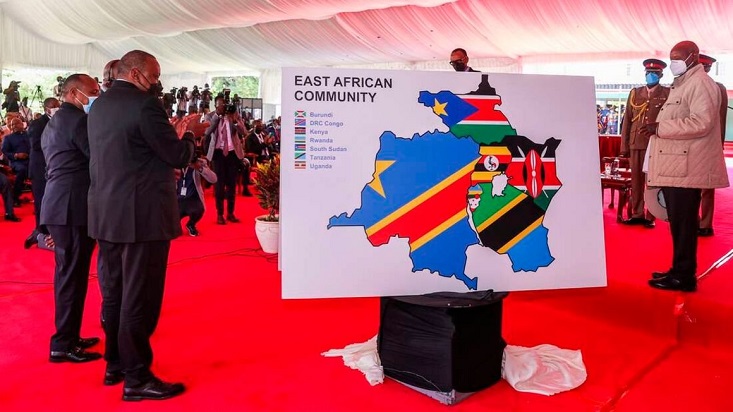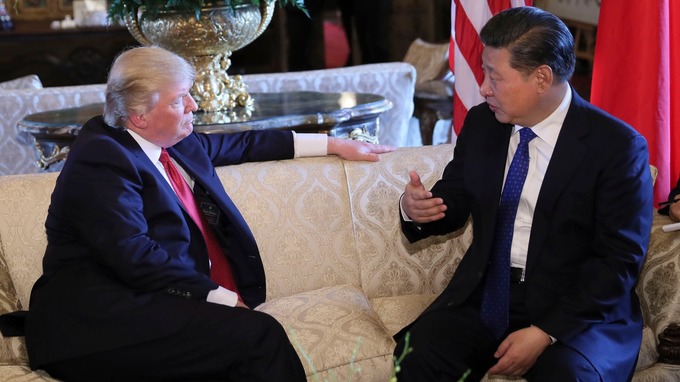EAC Heads of States during the Signing Ceremony of Treaty of Accession by the Democratic Republic of the Congo to the East African Community at State House, Nairobi. PHOTO | PSCU
The Democratic Republic of Congo on Monday completed the last and most important step of joining the East African Community (EAC).
At a function held at the EAC headquarters in Arusha, Tanzania, on Monday, the DRC officially became a member of the EAC after depositing instruments of ratification on the accession of the EAC Treaty with the bloc’s secretariat.
DRC now has full rights and privileges like any EAC member to participate in EAC’s programmes and activities and affirms to meet the obligations of the EAC.
With a population of about 92 million people, it holds almost half of the population of the EAC member states and is thus a huge market.
The entry of DRC portends growth in various sectors, and also increases the population to above 300 million.
The combined gross domestic product (GDP) will also rise to $250 Billion (UShs943.4 trillion).
The DRC’s entry is expected to remove restrictions on the free movement of people and goods and increase intra-EAC exports to the DRC, which currently stand at $7.4 billion.
Handing over the instrument of ratification to the EAC secretary-general, DRC Vice Prime Minister and Minister of Foreign Affairs Christophe Lutundula Apala Pen’ Apala, said the entry of his country into the EAC was an economic, cultural, geographical and historical obligation.
“The admission of DRC into the bloc is a fulfilment of the vision of the founding fathers of the Organisation of African Unity (now African Union) including Mwalimu Julius Nyerere, Mzee Jomo Kenyatta, Kwame Nkrumah and Patrice Lumumba all of whom wanted a strong, united and prosperous continent where people could trade and move freely,” said Mr Apala Pen’ Apala.
“Our entry will strengthen the bloc’s economic, political, socio-cultural, financial and military muscle.”
Depositing of instruments of ratification with the EAC secretary-general is the final step in the admission of a new member — as stipulated in the Treaty for the Establishment of the East African Community.
“This is a formalisation of a situation that has always been in existence. Somehow we can say the DRC joined their people,” said Mr Apala Pen’ Apala.
Often referred to as the ‘Giant of Africa’, the DRC presents a huge trade opportunity.
So far, almost half of the trade between the DRC and the EAC has been informal, implying that the potential for trade hasn’t been optimised.
“Admission of DRC into the EAC comes with increased GDP and expanded market size making EAC a home to about 300 million people, which is mutually beneficial to the people of both EAC and DRC by providing employment and investment opportunities that come along with this new development,” said Dr Peter Mathuki, the EAC secretary-general.
“The expanded membership makes the community bigger, with close to 50 percent increase in population, 22 percent increase in GDP and 79 percent expanded territorial area, spanning from the Indian to the Atlantic Ocean.”
The EAC anticipates that with lower tariffs on goods and the removal of trading restrictions among the partner states, goods and services will move more freely.
“Over the last seven years, the proportion of EAC exports to the DRC has averaged 13.5percent. But with the DRC now in the EAC, this is likely to change,” said Dr Mathuki.
“This milestone presents numerous opportunities for the people of the wider East Africa to take advantage of opportunities in trade, agriculture, manufacturing, technology, natural resources, education, and other fields of mutual interest.”
EAC trade with DRC has largely been informal and opportunities are hindered by the high cost of doing business due to the prevalence of non-tariff barriers.
With a larger market, manufacturers in the EAC, whether large or small and medium-sized enterprises (SMEs), will benefit from economies of scale, making them increasingly efficient and competitive.
“DRC has the potential for trade within the region and each EAC partner state is currently seeking a share of that trade,” said Dr Kevit Desai, the EAC and Regional Development PS.
The DRC shares borders with five of the partner states — Tanzania, Burundi, Rwanda, Uganda and South Sudan.
Kinshasa joining the community will open the corridor from the Indian Ocean to the Atlantic Ocean, as well as from North to South, expanding the economic potential of the region.
Kenyan firms that have expressed interest in the DRC include Jubilee Insurance, Equity Bank and the Kenya Commercial Bank (KCB), which have started a plan to enter the country through the acquisition of an existing lender.
“The fact that Equity has subsidiaries in DRC, South Sudan, Uganda, Rwanda and Tanzania, and Nairobi is the logistics hub for DRC’s needs for health, education and trade put us in the right place at the right time,” said Dr James Mwangi, the Equity Group CEO.
DRC’s entry also requires integrating the EAC’s trade infrastructure, intermodal connectivity, One-Stop Border Posts (OSBPs), and trade systems to reduce trade time and costs.
The joining of the DRC into the EAC will harmonise monetary and fiscal policy in the region making it easier to standardise tax regimes, improve cross-border trade and promote the free movement of persons and labour.
DRC imports more goods from China than the EAC and her entry into the regional bloc is likely to change the scenario.
The most sought-after products in DRC were non-alcoholic beverages ($ 55.2 million), raw cane sugar ($ 49.2 million), food preparations ($ 37.3 million) and sweet biscuits ($ 31 million).
In the textiles cluster, the DRC imported products worth $ 235.7 million in 2019, of which 54.6percent ($ 128.9 million) was supplied by China, according to a study report carried out by the East African Business Council dubbed, ‘The Opportunities for Trade in the DRC, a Perspective from East Africa 2019’.
In this category, the most sought-after were worn clothing and clothing accessories ($ 37.2 million), plain woven fabrics of cotton ($23.9 million), woven fabrics of yarn ($ 9.6 million) and men’s or boy’s trousers ($ 7.9 million), which the EAC must now position itself to supply.
Following its entry, the DRC will also be required to nominate nine members to the East African Legislative Assembly before the end of the year.
“The earliest the DRC’s members of Parliament will be able to join the East African Legislative Assembly is by December 2022 when the elections for new EALA members will be made,” said Aden Abdikadir, EALA MP.
-Business Daily





